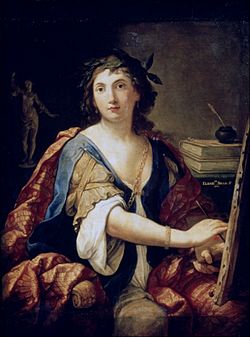Elisabetta Sirani
| Elisabetta Sirani | |
|---|---|

Self-Portrait as Allegory of Painting (1658) by Elisabetta Sirani, Pushkin Museum, Moscow.
|
|
| Born |
8 January 1638 Bologna, Italy |
| Died | 28 August 1665 (aged 27) Bologna, Italy |
| Nationality | Italian |
| Education | Family |
| Known for | Painting |
| Movement | Baroque |
Elisabetta Sirani (8 January 1638 – 28 August 1665) was an Italian Baroque painter and printmaker who died in still-unexplained circumstances at the early age of 27. She was the most famous woman artist in early modern Bologna and established an academy for other women artists.
Elisabetta Sirani was born in Bologna in January 1638, the first of four children of Margherita and Giovanni Andrea Sirani. She was trained by her father, a painter of the School of Bologna, who was a pupil of Guido Reni and an art merchant. Her biography is included in Carlo Cesare Malvasia’s two-volume Felsina pittrice: vite de’pittori bolognesi, or Lives of the Bolognese Painters, first published in 1678. Malvasia was personally acquainted with the Sirani family and actually took credit for recognizing Elisabetta’s talent and persuading her father to train her as an artist, although this was likely self-aggrandizing. Throughout his biography of Sirani, Malvasia praises the originality of her compositions, her style of drawing, her fast manner of working, and her professionalism, contrasting her with Lavinia Fontana, an earlier Bolognese woman painter whom he describes as timid. Giovanni Andrea Sirani became incapacitated by gout later in his career and Elisabetta began running her family's workshop by 1654. Her studio was incredibly successful, likely due to the progressive atmosphere of Bologna, where women artists were more welcome and celebrated. She trained a number of men and women artists, including her younger sisters Barbara and Anna Maria and a least 12 other young women.
Sirani died suddenly in August 1665, in Bologna. Her death was considered suspicious and a maidservant, Lucia Tolomelli, was charged with poisoning the artist and put on trial, but Giovanni Andrea Sirani withdrew the charges. Malvasia attributed her death to love-sickness because Sirani never married. Her actual cause of death was most likely the onset of peritonitis after a ruptured peptic ulcer. Sirani was given an elaborate funeral which included an enormous catafalque with a life-sized sculpture of the artist (illustrated in Malvasia's biography), orations and music composed in her honor, and she was buried in the Basilica of San Domenico, Bologna, in the same tomb as her father's teacher, Guido Reni.
...
Wikipedia
